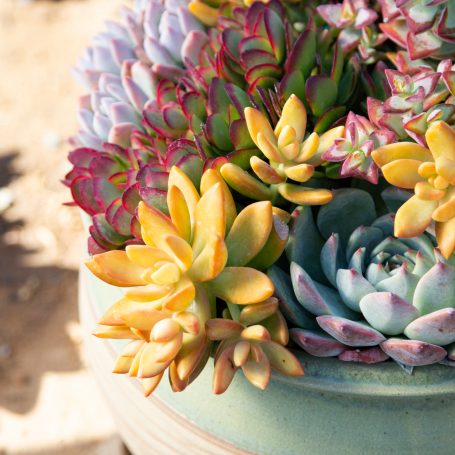A common query that I hear often is, “What are succulents?”. With their growing popularity, many people are still unfamiliar with these fascinating plants. Here is some more information that may help you to gain a better understanding of succulents.
When you buy something on this website, we may get a commission from your purchase. This doesn’t add any extra cost to you, but it helps us create free content for you to use.
Succulents are a type of plant that has adapted to store water in their leaves. The leaves become thick and fleshy, but there is variation in the amount of thickness between genera and species. These plants flourish in arid climates and cannot tolerate high levels of humidity.
In order to get the most out of your plants, it is important to provide them with the right amount of water. Too much can cause their roots to rot, and too little can cause them to suffer from drought. The key is to find a balance between the two, ensuring that their roots have access to enough moisture to thrive, while giving them time to absorb nutrients from the soil.
Most succulents cannot tolerate freezing temperatures, as it usually leads to death or mushy leaves due to the water stored in their leaves. However, certain varieties of sedums and sempervivums have been known to survive in temperatures below freezing, though they still prefer warmer climates.
Succulents may experience a change in color in response to drastic temperature shifts or insufficient water or sunlight. These plants are known to “blush” when exposed to a sudden influx of light, appearing in hues of pink, orange, purple, black, or red. When deprived of sunlight, the plants may appear dull or green.
One of the great things about succulents is how easily they can be propagated. Although some species are easier to propagate than others, many of them are able to grow new plants from a single leaf that has been separated from the plant. Some succulents will even sprout new pups as they get bigger. To learn more about propagating succulents, look for more information online!
Cactus are commonly distinguished from other succulents, which span a broad range of genera and species and come in a range of colors, shapes, and textures. A more extensive list of plants that belong to the succulent family can be found on Wikipedia.
Generally, people associate succulents with vibrant Echeverias, Sempervivums, or Senecio Rowleyanus ‘String of Pearls’. However, cacti with their spiny characteristics are also succulents.
Table of Contents
FAQ
Are cactus and succulents the same?
Cacti are a unique type of succulent plant that have the ability to store moisture, and they are classified in the family Cactaceae. However, not all succulents are cacti.
What makes a plant a succulent?
Can you eat any succulents?
Is Aloe Vera A cactus or succulent?
Succulents, such as Aloe Vera, are plants which have adapted to live in arid conditions by developing thick, fleshy parts that store water. These plants thrive in bright light, but should be protected from direct, intense sunlight. Aloe Vera can be grown indoors as a house plant, or outside in temperate climates.
How are succulents different from other plants?
Any plant which has thick, fleshy tissues that are adapted to store water is known as a succulent. Cacti are a prime example of a succulent, storing water mainly in the stem, and having no leaves or very small leaves. On the other hand, agaves are a succulent that stores water mainly in the leaves.

